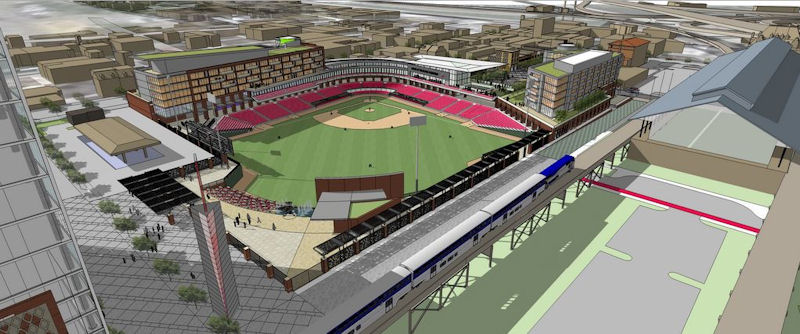by James A. Bacon
Mayor Dwight C. Jones unveiled this morning a $200 million public-private project to build a new baseball stadium and spark revitalization of a neglected corner of Richmond’s Shockoe Bottom district. The project includes 750 apartments, a Kroger grocery store, a 200-room Hyatt Hotel, a parking deck and a slavery memorial. The project will be cash-flow positive for the city, according to numbers released by City Hall and reported by the Times-Dispatch.
City officials say the resulting economic activity would generate “up to” $187 million in property and sales tax revenue over 20 years while the public cost of building a stadium for the Flying Squirrels AA baseball team and making other public improvements would amount to $80 million. Assuming those numbers are accurate, back-of-the-envelope calculations suggest that average tax revenues would exceed financing costs (principle and interest on bonds) by $2.5 million to $3 million yearly.
The proposal is sure to be controversial because the redevelopment project will overlay the site of the infamous Lumpkin Jail, which stood at the center of ante-bellum Richmond’s slave-trading complex. Jones’ plan would address historical-preservation concerns by erecting an interactive slavery memorial that incorporates the old African burial ground. While some local activists have opposed developing the site, a hallowed link to the history of Richmond blacks, no one has proffered a credible proposal for doing anything with the property. Under Jones’ plan, Capital One executive Steve Gannon would lead an effort to raise $30 million to create the slavery heritage memorial.
In the past, such a project might well have ignited a racial controversy. But a new generation of pragmatic African-American leadership has risen to power in Richmond that seems more interested in governing than cultivating grievances. No one can question Jones’ bona fides as a champion of the city’s poor. Earlier this year the mayor rolled out an ambitious plan to de-concentrating poverty in the poverty-ridden East End by redeveloping a major commercial corridor as mixed-use and mixed-income development.
Jones also understands that fighting poverty must be balanced by efforts to grow the city’s tax base. As the city’s press release makes plain, “all decisions are being made through the lens of economic development, creating jobs and expanding the city’s tax base. ” The project would create 1,000 construction jobs and 400 permanent jobs.
Presumably, many of the permanent, stadium-related jobs would be filled by residents of nearby poor neighborhoods. The stadium scheme will accomplish several other goals: (1) solve the perennial problem of where to create a long-term home for the Flying Squirrels, (2) accelerate re-development of Shockoe Bottom and (3) free the current Richmond Diamond site on the Boulevard for re-development. Moreover, 750 apartments – presumably serving the middle- and professional-class demographic — will bring back into the city more tax-paying citizens who demand relatively little in the way of city services.
From a high-altitude perspective, the proposal seems to make a lot of sense. But it must withstand close public scrutiny. City Hall needs to answer some important questions before the project can move forward:
- Do the revenue numbers stand up? Are they based on speculative assumptions that, for instance, baseball fans will dine or shop in Shockoe Bottom before going to the games? What are the risks that the hoped-for private-sector development and attendant tax revenues will not materialize or be slower than expected to materialize?
- What impact will incurring debt have on the city’s AA bond rating? To what extent will borrowing $80 million crowd out other capital improvements? Could the city invest its borrowing capacity more cost-effectively elsewhere?
- How will the stadium impact Shockoe Bottom parking? Will the stadium compete with existing uses (daytime commercial, evening entertainment and residential) and create shortages, or will it complement existing uses by scheduling games during off-peak periods?
- Can the existing Interstate 95 on- and off-ramps accommodate the surge of automobiles during events? How severe will the congestion be, how far will it spread and how long will it last?
- Will the design of the stadium apartments and grocery store adhere to the principles of walkable urbanism or will it conflict? One specific question: Will the grocery store be surrounded by a large parking lot, or will it be integrated into the urban fabric?
In theory, the project should be highly positive for Richmond. Aside from building a new baseball stadium (a benefit to which I am entirely indifferent) it will bring the first large grocery store downtown, a critical amenity for supporting continued re-population of the city core. As a bonus, the presence of a Kroger store would roll back the “food desert” in which poor inner-city residents lack access to reasonably priced fresh fruits and vegetables. If the design is done properly, the project will upgrade streetscapes and improve walkability for a big chunk of the Shockoe Bottom district. Finally, the stadium project opens up land currently dedicated to the Diamond stadium near the Boulevard and Interstate 95 for re-development. The nearby industrial zone of Scott’s Addition is already hopping with residential and commercial projects. The Diamond tract would lend itself wonderfully to mixed-use development.
The devil, of course, is in the details. But there should be enough economic value added in the stadium project to create a win-win for everyone, and Jones has shown himself to be the kind of leader to make make sure there’s something in it for everyone.
Update: “Breckinridge” raises a good point in the comments: How much of the land will have to be acquired through eminent domain? He says the Havana ’59 restaurant (a fun, fun restaurant) would get wiped out by the plan. I have strong reservations about eminent domain being used for “economic development” purposes. Indeed, doesn’t the amended state constitution ban such a use?



